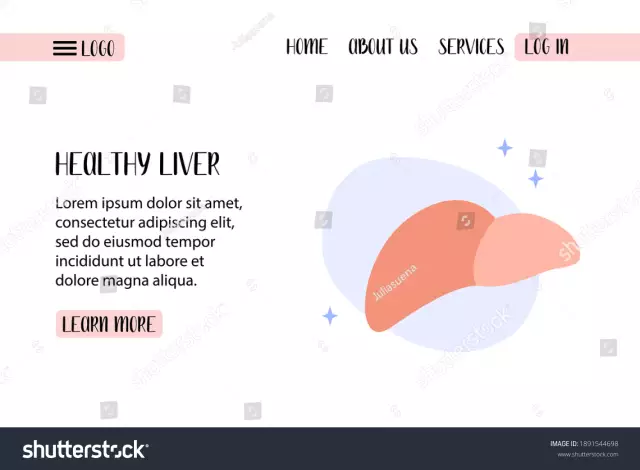- Author Rachel Wainwright [email protected].
- Public 2023-12-15 07:39.
- Last modified 2025-11-02 20:14.
Interstitial lung disease
The content of the article:
- Causes and risk factors
- Forms of the disease
- Disease stages
- Symptoms
- Diagnostics
- Treatment
- Possible complications and consequences
- Forecast
- Prevention
Interstitial lung diseases (ILD) are a large group of pulmonary diseases characterized by a diffuse inflammatory process that affects the alveoli, bronchioles, pulmonary capillaries, the outcome of which is fibrosis.
Among the total number of patients with pulmonary profile, patients with IDL make up 10-15%. Most often, these pathologies are diagnosed in smoking men aged 40 to 70 years.

The IDL group includes many pulmonological diseases
Causes and risk factors
To date, the exact causes of the development of interstitial lung diseases are unknown, however, a number of predisposing factors have been identified:
- smoking;
- exposure to ionizing radiation;
- therapy with toxic drugs (bleomycin, penicillamine, cyclophosphamide);
- regular inhalation of mercury vapor, organic dust, or inorganic substances;
- respiratory tuberculosis;
- recurrent viral, fungal and bacterial pneumonia;
- bronchoalveolar cancer;
- respiratory distress syndrome;
- hereditary predisposition;
- blood diseases (chronic lymphocytic leukemia, thrombocytopenic purpura, hemolytic anemia);
- collagenosis.
Forms of the disease
Interstitial lung diseases include over 130 different diseases. In 2002, a classification system for these diseases was developed by the European Respiratory Society and the American Thoracic Society. In accordance with it, they are divided into the following forms:
- Interstitial lung diseases of established etiology.
- Interstitial idiopathic pneumonia (cryptogenic, lymphoid, acute, desquamative, nonspecific).
- Granulomatous ILD (develop against the background of allergic exogenous alveolitis, pulmonary hemosiderosis, Wegener's granulomatosis, sarcoidosis).
- ILD associated with other diseases (malignant neoplasms, neurofibromatosis, chronic renal failure, Crohn's disease, ulcerative colitis, biliary cirrhosis, chronic hepatitis).
- Other IZL. These include forms of the disease that develop against the background of primary amyloidosis of the lungs, pulmonary proteinosis, lymphangioleiomyomatosis, histiocytosis of H.

Classification of interstitial lung diseases
Interstitial lung diseases with an established etiology are subdivided, in turn, into the following groups:
- toxic, radiation and medicinal;
- pneumomycosis associated with HIV infection;
- ILI, which have arisen against the background of collagenosis (systemic lupus erythematosus, rheumatoid arthritis, dermatomyositis, scleroderma) or pneumoconiosis (beryllium, silicosis, asbestosis);
- ILD, developed against the background of long-term infectious processes (pneumocystis pneumonia, respiratory tuberculosis, atypical pneumonia);
- IPL against the background of allergic exogenous alveolitis.
Disease stages
In the clinical picture of interstitial lung diseases, there are three stages replacing each other:
- Sharp. The inflammatory process captures the alveolar epithelium and the capillary network of the lungs. The development of intraalveolar edema is observed.
- Chronic. Extensive replacement of the interstitial tissue of the lungs with fibrous tissue (widespread fibrosis) occurs.
- Terminal. Fibrous tissue almost completely replaces capillaries and alveoli, as a result of which the lung takes on the appearance of a honeycomb (the presence of multiple dilated cavities in the tissue).
Symptoms
The clinical course of all forms of interstitial lung disease is characterized by respiratory and general symptoms. In most cases, the disease begins gradually.
The general symptoms of ILD are indistinct and non-specific. It includes:
- increased fatigue;
- general malaise;
- subfebrile condition (increase in body temperature to 37.9 ° C);
- weight loss.

Fatigue and general weakness are some of the symptoms of interstitial lung disease
The first respiratory symptom of interstitial lung disease is shortness of breath. At first, it occurs only under the influence of physical activity and disappears during rest, but over time it becomes constant. Shortness of breath is of an inspiratory nature (difficulty breathing) and is often combined with wheezing.
A little later, a dry or unproductive cough with scanty mucous sputum joins shortness of breath. As respiratory failure increases, cyanosis appears and increases in patients. The fingers are gradually deformed like the fingers of Hippocrates (symptoms of drumsticks and watch glasses). In some cases, chest deformity occurs.
In the terminal stage of the disease, the manifestations of chronic pulmonary and heart failure rapidly increase in patients.
Diagnostics
With this pathology, physical changes in the lungs do not correspond to the severity of tachypnea and shortness of breath. During auscultation, the following changes are noteworthy:
- tachycardia;
- muffled heart sounds;
- crepitus during inhalation.

IPL is diagnosed using bronchoscopy
If interstitial lung disease is suspected, a laboratory and instrumental examination is performed, including:
- general blood analysis;
- analysis of gas and acid-base composition of blood;
- X-ray of the lungs;
- computed tomography of the chest organs;
- electrocardiography;
- diagnostic bronchoscopy;
- transbronchial, transthoracic, or open lung biopsy.
Treatment
Therapy of interstitial lung diseases begins with the exclusion of further contact of the patient with provoking factors (from smoking cessation, withdrawal of toxic drugs, cessation of interaction with harmful production factors).
To reduce the activity of the inflammatory process, corticosteroids are prescribed in high doses. As the condition improves, the dosage is gradually reduced to a maintenance one. If therapy with corticosteroids does not lead to a persistent therapeutic effect, cytostatics are prescribed.

In the treatment of ILD, corticosteroids, anticoagulants, bronchodilators, cardiac glycosides are used
Also, the treatment regimen for interstitial lung diseases usually includes:
- bronchodilators;
- anticoagulants;
- cardiac glycosides;
- oxygen therapy.
In the terminal stages of the disease, lung transplantation is the only way to save the patient's life.
Possible complications and consequences
The main complications of interstitial lung disease:
- chronic pulmonary heart failure;
- pulmonary hypertension;
- cachexia.
Forecast
The prognosis for interstitial lung disease is determined by the form of the disease. For example, patients with respiratory bronchiolitis live for more than 10 years, and the life expectancy of patients with Hammen-Rich syndrome does not exceed one year.
Prevention
Prevention of interstitial lung disease is as follows:
- timely and adequate treatment of viral infections;
- to give up smoking;
- observance of labor protection rules, allowing to reduce contact with occupational hazardous factors.

Elena Minkina Doctor anesthesiologist-resuscitator About the author
Education: graduated from the Tashkent State Medical Institute, specializing in general medicine in 1991. Repeatedly passed refresher courses.
Work experience: anesthesiologist-resuscitator of the city maternity complex, resuscitator of the hemodialysis department.
The information is generalized and provided for informational purposes only. At the first sign of illness, see your doctor. Self-medication is hazardous to health!






